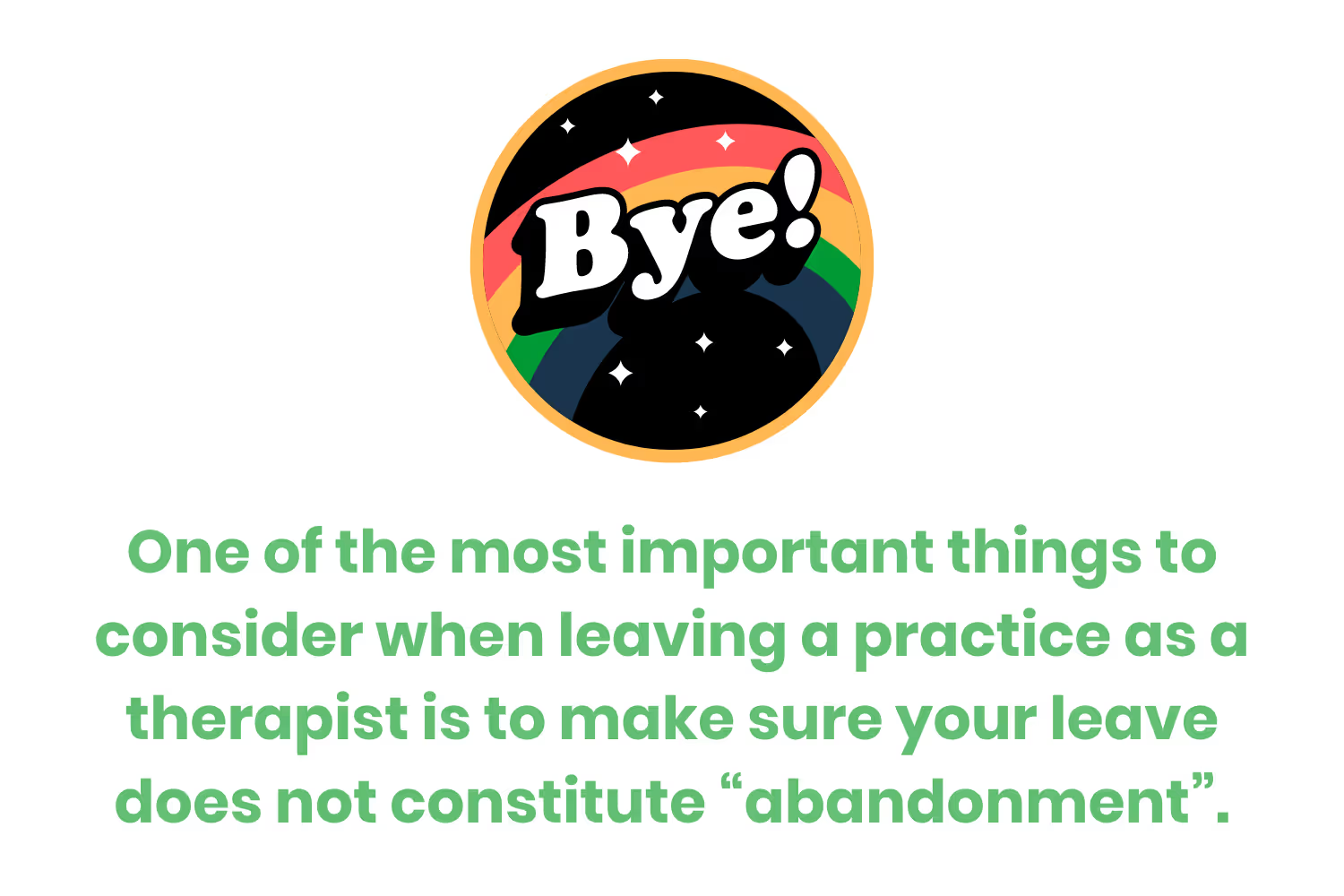4 Thorough Letter Samples of a Therapist Leaving a Practice
When taking into consideration everything you need to do, the most important thing to remember is to notify patients of the therapist leaving the practice. Whether you’re the therapist or the practice manager, here are 4 examples of effective letters to announce resignation.

Between 30% and 60% of mental health professionals leave their organizations annually.
There are many reasons why an employee might leave their place of work. Maybe they have an offer to start their dream job at a moment’s notice. Or perhaps the employee is unhappy. It could be because of pay, work hours, or the work environment itself.
For most people, giving a 2 weeks notice is sufficient before leaving a job. Writing a resignation letter and designating job responsibilities to another employee can also be part of a basic termination process.
Some employees even leave with no notice and no formal documentation, but we don’t recommend that for any job. I don’t recommend going this route in most cases, though.
However, licensed mental health professionals must abide by stricter labor laws, rules, and standards. These are of course about “termination” or taking leave. Ethical practice and conduct must meet these standards at all times. Even when ending the therapeutic relationship with a client.

Therapists who inappropriately or abruptly terminate their practice can negatively affect their clients. This can cause a setback in client progress as well as place stress on the remaining staff.
So as you can see, leaving your practice as a therapist can be more complicated than your average 9 to 5 office. Because patients share their most intimate and personal details with their therapist, the industry as a whole is highly regulated.
Your therapist can’t just take off without saying so much as a goodbye. There’s a little more nuance to it, some of which must abide by the law.
When taking into consideration everything you need to do, the most important thing to remember is to notify patients of the therapist leaving the practice. Whether you’re the therapist or the practice manager, here are 4 examples of effective letters to announce resignation.
Patient Notification Requirements
Therapists have many obligations to their clients that ensure their best interests come first.
These obligations are fiduciary responsibilities, with the therapist being the fiduciary. Jorgenson, Hirsch, and Wahl (1997) describe a fiduciary relationship as a psychotherapist as…
- When one party, the fiduciary, accepts the trust and confidence of another party.
- The fiduciary agrees to act only in the entrustor’s best interest.
- The professional, by virtue of his or her status as a fiduciary, has both the power and opportunity to exert undue influence over the client.
This fiduciary responsibility exists not only in regard to the care of a patient but also when it comes to the termination of the therapist-client relationship. Termination in this case is the ethically and clinically appropriate process by which a professional relationship ends. So this includes when a therapist leaves a practice or retires.
Thankfully, the American Psychological Association’s (APA) Ethical Principles of Psychologists and Code of Conduct provides clear guidance on the responsibilities to clients regarding the termination of a relationship no matter the reason.
One of the most important things to consider when leaving a practice as a therapist is to make sure your leave does not constitute “abandonment”.
Abandonment occurs when the therapist ends the treatment relationship without setting a plan for the ongoing treatment needs of the client or referrals. Giving a patient adequate notice of taking leave of a practice or organization as well as relevant referrals for other treatment options can help guard against this. If a healthcare professional abandons a case without meeting these requirements, the therapist or practice could face legal ramifications.
The patient should receive referral information both verbally and in writing, with a copy made to keep in the patient’s file. A letter to the patient is generally an appropriate way to go about making sure a patient understands this information.

Ethical Leaving Practice Notifications
Sending a notification is the last step in a laundry list of steps to take when leaving a practice. Making sure to include referrals in these letters and a number to call for any further questions ensures a successful termination.

Although we’re talking about therapists in this article, those who manage others must also be mindful of these steps. Supervisors who ask an employee to leave immediately should recognize the ethical situation they may cause. Those who manage agencies should consider their work environment as well in the case that an employee leaves.
Making sure work expectations and demands are reasonable and fair can help therapists work effectively. Thus, reducing the amount of turnover. But, that’s a whole separate issue. Let’s take a look at some examples of termination letters, and why they are or aren't appropriate.
Example 1: Mail Letter
For this first example, the reason they give for termination in the letter isn’t for leaving a practice. Yet, this exact letter template will also work if you were to take leave or find a new job.
You can see that the letter references the adequate amount of time before termination. This therapist lets their patient know that they will no longer be able to continue their care after 30 days. The therapist also makes sure to let the patient know that they’ll be able to further discuss the next steps. They add in the letter that referrals will be available to the patient upon request.

Depending on the severity of the case, however, it’s not always appropriate to direct a client to their insurance company for more referrals. This is especially true for therapists who work in a private practice that does not take insurance.
Example 2: Email
Around 60% of people regularly receive mail that’s for the previous resident of their home. Have you ever gotten a piece of mail that has someone’s name on it that you don’t even know? I know I do… all of the time. Don’t worry, I make sure to take Jeff’s mail back to the USPS every time I get something of his. I’ll take this moment to ask Jeff, if he is reading this, to please update his address.
My whole point here is that sometimes mailing a notice can hold the risk of not making it to the client. It could be because the clearinghouse the letter came from had technical difficulties and didn’t print it properly. Or it could simply be due to an address problem. On a side note, that’s why you should always keep a copy of the notification in the client’s file.

If you want to double down on methods of communication, consider using email. This way, you have better odds of getting into contact with the client right away. Let’s look at this next example of an email template sent from a medical professional discontinuing their practice.
This professional made sure to notify their client in adequate time with the necessary information, but there’s a problem in this example. If you notice, the professional doesn’t suggest any referrals but instead puts this task on the client.
When possible, referring an actual professional or directing to another agency is the appropriate way to go about this.
Example 3: Social Media
As of April 2022, there were more than 5 billion internet users worldwide. That’s just over 63% of the global population! Of this total, 4.7 billion are social media users.
That’s why companies today rely on social networks to push their products. The likelihood of their advertisement gaining attention and traffic on Instagram or Facebook is quite high. For practices and agencies, announcing new therapists and professionals on their socials is a great way to update clients!

But on the flip side, this method can also work for announcing a professional leaving a practice.
In an age where we’re constantly taking in information, this could be the reminder a client needs to check their mail or email for your notice.
Example 4: Blog Post
Speaking of online information and social media here’s something to consider. Linking your announcement to a blog post with further information is another way to reach the masses.
Letting clients know who’s leaving and when can take place in the comfort of your own company webpage.
So long as the information is not sensitive, listing the references in this way can help you take proactive action against abandonment claims. Make sure to still post this blog with plenty of time before the therapist’s leave date and with contact information for any follow-up questions.

Conclusion
While it’s ethical to take into consideration a patient’s state of mind, therapists aren’t expected to stay at the same practice forever. At the end of the day, mental health experts are also trying to better their career paths.
Yet, mental health experts are also held to a higher standard due to the sensitive nature of their job. This is why there are standards and guidelines to follow when considering leaving a practice or agency.
By doing so, even if you must terminate your therapist-patient relationship, you can still do it ethically.
Emphasize your product's unique features or benefits to differentiate it from competitors
In nec dictum adipiscing pharetra enim etiam scelerisque dolor purus ipsum egestas cursus vulputate arcu egestas ut eu sed mollis consectetur mattis pharetra curabitur et maecenas in mattis fames consectetur ipsum quis risus mauris aliquam ornare nisl purus at ipsum nulla accumsan consectetur vestibulum suspendisse aliquam condimentum scelerisque lacinia pellentesque vestibulum condimentum turpis ligula pharetra dictum sapien facilisis sapien at sagittis et cursus congue.
- Pharetra curabitur et maecenas in mattis fames consectetur ipsum quis risus.
- Justo urna nisi auctor consequat consectetur dolor lectus blandit.
- Eget egestas volutpat lacinia vestibulum vitae mattis hendrerit.
- Ornare elit odio tellus orci bibendum dictum id sem congue enim amet diam.
Incorporate statistics or specific numbers to highlight the effectiveness or popularity of your offering
Convallis pellentesque ullamcorper sapien sed tristique fermentum proin amet quam tincidunt feugiat vitae neque quisque odio ut pellentesque ac mauris eget lectus. Pretium arcu turpis lacus sapien sit at eu sapien duis magna nunc nibh nam non ut nibh ultrices ultrices elementum egestas enim nisl sed cursus pellentesque sit dignissim enim euismod sit et convallis sed pelis viverra quam at nisl sit pharetra enim nisl nec vestibulum posuere in volutpat sed blandit neque risus.

Use time-sensitive language to encourage immediate action, such as "Limited Time Offer
Feugiat vitae neque quisque odio ut pellentesque ac mauris eget lectus. Pretium arcu turpis lacus sapien sit at eu sapien duis magna nunc nibh nam non ut nibh ultrices ultrices elementum egestas enim nisl sed cursus pellentesque sit dignissim enim euismod sit et convallis sed pelis viverra quam at nisl sit pharetra enim nisl nec vestibulum posuere in volutpat sed blandit neque risus.
- Pharetra curabitur et maecenas in mattis fames consectetur ipsum quis risus.
- Justo urna nisi auctor consequat consectetur dolor lectus blandit.
- Eget egestas volutpat lacinia vestibulum vitae mattis hendrerit.
- Ornare elit odio tellus orci bibendum dictum id sem congue enim amet diam.
Address customer pain points directly by showing how your product solves their problems
Feugiat vitae neque quisque odio ut pellentesque ac mauris eget lectus. Pretium arcu turpis lacus sapien sit at eu sapien duis magna nunc nibh nam non ut nibh ultrices ultrices elementum egestas enim nisl sed cursus pellentesque sit dignissim enim euismod sit et convallis sed pelis viverra quam at nisl sit pharetra enim nisl nec vestibulum posuere in volutpat sed blandit neque risus.
Vel etiam vel amet aenean eget in habitasse nunc duis tellus sem turpis risus aliquam ac volutpat tellus eu faucibus ullamcorper.
Tailor titles to your ideal customer segment using phrases like "Designed for Busy Professionals
Sed pretium id nibh id sit felis vitae volutpat volutpat adipiscing at sodales neque lectus mi phasellus commodo at elit suspendisse ornare faucibus lectus purus viverra in nec aliquet commodo et sed sed nisi tempor mi pellentesque arcu viverra pretium duis enim vulputate dignissim etiam ultrices vitae neque urna proin nibh diam turpis augue lacus.



![[ANSWERED] What is a Long-Term Care (LTC) Pharmacy](https://cdn.prod.website-files.com/67e2b8210878abcba6f91ae6/68d687806a075a1cf64659b0_WhatisLongTermCarePharmacy_925.avif)
